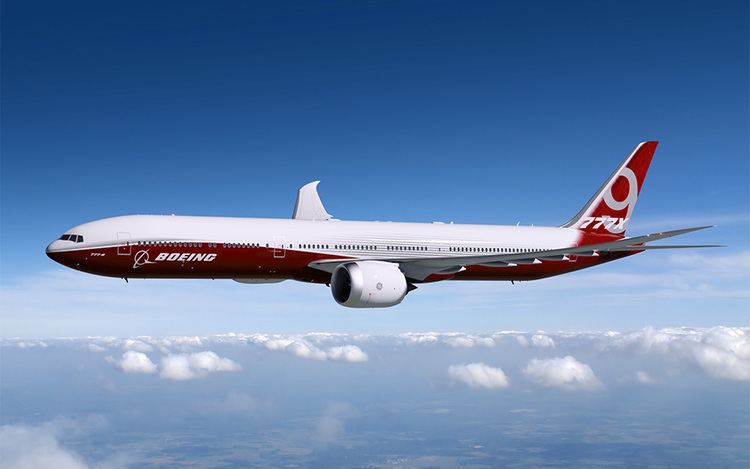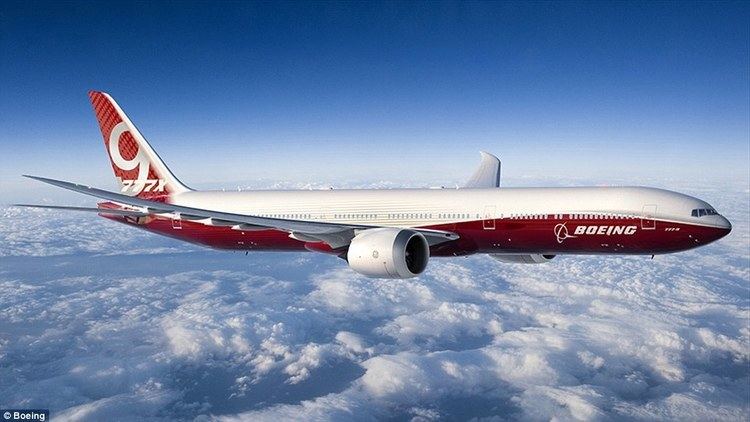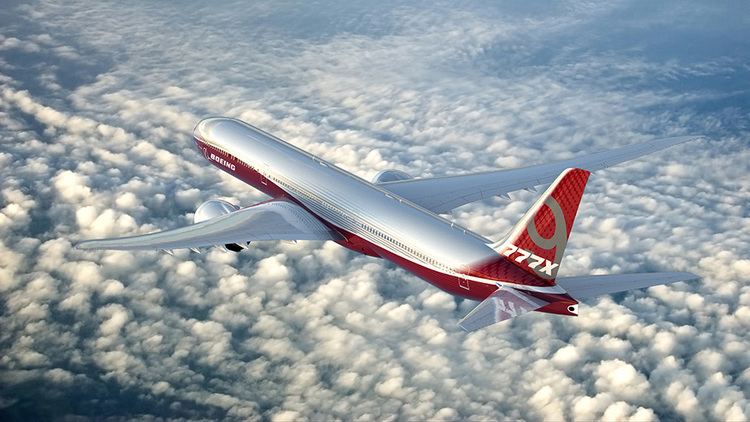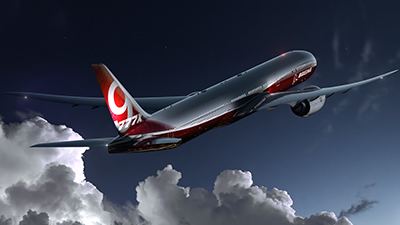Wingspan 72 m | ||
 | ||
Manufacturer | ||
Introducing the new boeing 777x
The Boeing 777X is a new series of the Boeing 777 family under development. The 777X will have two variants; the 777-8 and the 777-9. The 777X will feature new engines, new composite wings with folding wingtips, and technologies from the Boeing 787. It is intended to compete with the Airbus A350. Deliveries are expected to begin in 2020.
Contents
- Introducing the new boeing 777x
- Studies
- Initial design
- Powerplant selection
- Launch
- Production
- Design
- Variants
- 777 8
- 777 9
- 777 10X
- Orders
- References

Studies
In September 2011, Boeing released more details on proposed new 777 versions, tentatively designated 777-8X and 777-9X, and collectively referred to as 777X. Preliminary estimates placed entry into service for the first 777X variants at around 2019. In August 2012, a report in the Seattle Times stated that Boeing had slowed 777X development, but still planned for it to begin service by about 2019. In May 2013, Boeing's board of directors gave formal permission for its Commercial Airplanes division to start offering the 777X to customers.

On September 18, 2013, Lufthansa's supervisory board gave approval to order 34 Boeing 777-9X aircraft to replace its 747-400s. At the time, Boeing was reportedly planning to launch the 777X series later in 2013. In October 2013, Boeing announced that its U.S. facilities in Charleston, Huntsville, Long Beach, Philadelphia, and St. Louis as well as Russian facilities in Moscow would support the 777X design effort.
Initial design

The 777-9X would feature extended horizontal stabilizers compared to the -300ER and a fuselage stretch of 7.0 ft (2.13 m) to a total length of 250 ft 11 in (76.5 m) to accommodate 407 passengers. The 777-9X's planned length exceeds the 250 ft 2 in (76.3 m) length of the Boeing 747-8, currently the world's longest airliner. Wingspan was expected to increase from the current 212 ft 7 in (64.8 m) to 234 ft (71.3 m), and incorporate the use of carbon-fiber-reinforced polymer in its construction.

In addition, gross weight was tentatively slated to decrease slightly from the current 775,000 lb (352,000 kg) to approximately 759,000 lb (344,000 kg) for the -9X model. Boeing was also studying an ultra long-range replacement for the 777-200LR, conceptually dubbed the 777-8LX, which would share the −9X's fuel capacity and gross weight. Its range will be 9,480 nmi (10,910 mi; 17,560 km) compared to 9,395 nmi (10,812 mi; 17,400 km) for the −200LR. The 777-8LX's fuselage length would match that of the proposed −8X at 228.17 ft (69.5 m).
Powerplant selection

In February 2012, General Electric disclosed studies on a slightly smaller engine, dubbed the General Electric GE9X, to power the 777X. The engine was to use the same fan diameter from the GE90-115B (128 in or 325 cm) and have a decreased thrust rating per engine of 99,500 lbf (443 kN) for the -9X and -8XL, and 88,000 lbf (390 kN) for the -8X. Rolls-Royce and Pratt & Whitney proposed powerplants for the 777X, including the RB3025 concept, based on the Trent 1000 and Trent XWB engines, and an adaptation of PW1000G engine architecture to produce up to 100,000 lbf (440 kN) of thrust.
In March 2013, the GE9X was selected as the exclusive engine to power the 777X. GE subsequently updated the GE9X specifications to reflect growing concerns that the 777X would be underpowered. Design changes included an increase of thrust to 102,000 lbf (450 kN), and then up to 105,000 lbf (470 kN) with a new fan diameter of 132 in (335 cm), giving the new engine the largest fan GE has ever produced.
The decision to offer the aircraft with only one engine type is somewhat controversial. Some airlines bemoan the loss of competition among engine makers; Steven Udvar-Hazy, CEO of Air Lease Corp., said that he wants a choice of engines. Airbus has pointed out that equipping a commercial aircraft to handle more than one type of engine adds millions of dollars to the purchase price. A Pratt & Whitney executive told the Wall Street Journal, "Engines are no longer commodities...the optimization of the engine and the aircraft becomes more relevant."
Launch
Boeing officially launched the 777X at the 2013 Dubai Airshow in November 2013, announcing a total of 259 orders and commitments worth more than US$95 billion. According to Boeing, this was the largest product launch by dollar value in the history of commercial aviation.
In addition to the 34 aircraft commitment from Lufthansa in September 2013, Boeing received orders and commitments at the Dubai Airshow for 150 aircraft from Emirates, 25 aircraft from Etihad Airways, and 50 aircraft from Qatar Airways. The 777X program includes two models: the 777-9, which is stretched beyond the length of the 777-300ER, and the 777-8, which is sized close to the 777-300ER but with ultra-long range capability.
During the 2015 Dubai Airshow, Boeing officially dropped the 'X' suffix from the names of the individual variants, referring to the variants as Boeing 777-8 and 777-9. The new series is still marketed as the Boeing 777X.
Production
In December 2014, Boeing began construction on a new 367,000-square-foot (34,100 m2) composites facility in St. Louis to build 777X parts; completion is set for 2016. The expansion will create about 700 new jobs. The facility will feature six autoclaves with work on 777X wing and empennage parts to start in 2017.
In May 2015, Boeing announced it would convert the current 787 'surge' line at Everett by the end of 2015 into an early production line for the 777X with the first 777X expected to roll off that line in 2018.
Because deliveries of the 777X are not expected to begin until 2020, Boeing faces the challenge of maintaining an efficient production line for its existing 777 models. With 380 777s on order as of the end of 2013, and no orders booked at the most recent air show, in Singapore in February 2014, Boeing was trying to support a production rate of 100 aircraft per year on that line. To stimulate additional orders and bridge the gap until 777X models roll off the assembly line, Boeing vice president of sales John Wojick proposed pairing 777X sales with sales of current generation models, and providing opportunities for passenger airlines to sell their used 777 aircraft for conversion to freighter aircraft. The airlines could then purchase new 777 passenger aircraft.
Design
For the 406-seat 777-9, newer engines should improve fuel consumption by 10% and the longer carbon-fibre wings by 7%. As 4-5% is lost from the 12 tons heavier basic structure of the larger airliner, the net gain is 12-13%. Four inches of extra cabin width are carved in the inside of the fuselage to allow 10-abreast seating instead of nine and the 2-3 rows longer fuselage enable a fuel burn per seat reduction of 20% compared to the 777-300ER with 41 more seats. The longer-range 777-8 should seat 355. It should have a 13% improvement with 10 fewer seats than the current -300ER.
Design plans call for the 777X to feature cabin design details that were originally introduced on the Boeing 787 Dreamliner. These include larger windows than prior commercial aircraft, increased cabin pressure equivalent to 6,000 feet (1,800 m) altitude, higher ceilings, and more humidity. Structural changes are required versus the original 777 fuselage design in order to incorporate these design improvements as well as greater cabin width.
To stay within the size category of the current 777 with a less than 65 metres (213 ft) wingspan, it will feature 3.5 metres (11 ft) folding wingtips supplied by Liebherr Aerospace from Lindenberg. The mechanism was demonstrated for Aviation Week at the Boeing Everett Factory in October 2016 : the movement should be complete in 20 seconds and locked in place at the end. Its maximum takeoff weight is targeted for 775,000 pounds (351,500 kg) like the 777-300ER but Boeing hopes to have at least a 10,000 pounds (4,500 kg) margin at introduction.
Variants
The 777X will have a new larger wingspan composite wing with folding wing tips. The internal cabin width is increased to 19 ft 7 in (5.97 m) from the 19 ft 3 in (5.87 m) width of previous 777 models, through the use of thinner interior cabin walls and better insulation. This will allow 10-abreast economy seating with 18.0 in (46 cm) wide seats.
777-8
The 777-8 is a shortened derivative of the 777-9X, 229 ft (69.8 m) long, between the 209 ft 1 in (63.7 m) 777-200 and 242 ft 4 in (73.9 m) 777-300. It will seat typically 350-375 passengers with a range of over 8,700 nmi (16,100 km). It would succeed the ultra-long-range -200LR, and competes with the Airbus A350-1000. Production on the -8 will follow the -9 around two years later. It could be the basis of a freighter version which could be available 18 to 24 months after the -8 introduction.
777-9
The 777-9 is a 9.4 ft (2.9 m) longer derivative of the 777-300ER for a 251 ft 9 in (76.7 m) length. It will seat typically 400-425 passengers over a range of 7,600 nmi (14,100 km). Boeing froze its design in August 2015 and should start first assembly in 2017, for an introduction in December 2019. The operating empty weight of the -9X is targeted at just over 400,000 lb (181,400 kg) instead of around 373,500 lb (169,400 kg) for the 777-300ER.
777-10X
Boeing is proposing to stretch the -9 by four seat rows to accommodate 450 passengers in a 777-10X and compete with the Airbus A380 superjumbo. It has approached several airlines including Emirates, the largest operator of both the B777 and the A380, seating between 489 and 615 passengers. The potential 263 feet (80 m) long airplane (12 ft more) is competing against a hypothetical stretch of the A350-1000 for Singapore Airlines.
Orders
In December 2013, Hong Kong-based Cathay Pacific ordered 21 777-9 airliners with deliveries from 2021 to 2024. By April 2014, with cumulative sales surpassing those of the 747, the Boeing 777 became the best-selling wide-body airliner; at existing production rates, the aircraft was on track to become the most-delivered wide-body aircraft by mid-2016.
Emirates finalized its order for 150 777X aircraft, consisting of 115 777-9s and 35 777-8s in July 2014. On July 16, 2014, Qatar Airways finalized its order for 50 777-9 airplanes, with purchase rights for 50 more 777-9s. On July 31, 2014, Japan's All Nippon Airways finalized an order for 20 Boeing 777-9s. On December 11, 2016, Iran Air signed an agreement with Boeing for 80 airliners including 15 777-9s; Boeing does not list this as a firm order as of January 2017. On February 9, 2017, Singapore Airlines signed a letter of intent with Boeing for 20 777-9 and 19 787-10 airliners.
Notes
